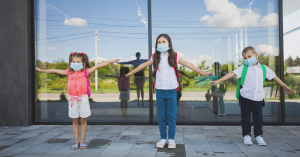Abdominal pain is one of the most frequent complaints in children, ranging from mild issues like indigestion to serious conditions such as appendicitis. Appendicitis is an inflammation of the appendix and can become life-threatening if not treated quickly. Since its symptoms can be mistaken for other illnesses, early recognition is critical.
What is the Appendix and Why is it Vestigial?
• The appendix is a small, finger-shaped pouch connected to the large intestine, located in the lower right side of the abdomen.
• It is considered a vestigial organ, meaning it no longer serves a vital function in the human body.
• In the past, it may have helped our ancestors digest tough plant materials.
• Some studies suggest it might help store beneficial gut bacteria, but the body functions perfectly well without it.
What is Appendicitis?
• Appendicitis happens when the appendix becomes inflamed, swollen, and infected.
• This inflammation usually occurs due to a blockage in the appendix, caused by:
• Hardened stool (fecaliths)
• Swollen lymph nodes
• Infections
• Parasites or foreign objects
• If left untreated, the appendix can burst (rupture), leading to a serious infection called peritonitis.
Symptoms of Appendicitis in Children
Recognizing appendicitis can be tricky, especially in younger children who can’t clearly describe their symptoms. Look for these signs:
Abdominal Pain:
• Starts near the belly button and moves to the lower right side.
• Becomes sharp, constant, and worsens with movement, coughing, or pressing on the area.
Nausea and Vomiting:
• Vomiting usually happens after the onset of pain.
• This is different from conditions like stomach flu, where vomiting often comes first.
Loss of Appetite:
• A key sign—children may refuse to eat or drink, even their favorite foods.
Fever:
• A low-grade fever may be present initially.
• A high fever may develop if the appendix bursts.
Changes in Bowel Movements:
• Constipation or diarrhea may occur.
• Some children may have difficulty passing gas.
Behavioral Changes:
• Irritability, fatigue, or reluctance to walk or move due to pain.
• Younger children may curl up in pain or refuse to be touched on the belly.
How is Appendicitis Different from Other Types of Stomach Pain?
Appendicitis can be confused with other common stomach issues, but some key differences can help you identify it:
Pain Pattern:
• Appendicitis pain starts around the belly button, then shifts to the lower right side.
• The pain worsens steadily, unlike gas pain or mild stomach aches that come and go.
Appetite Loss:
• Children with appendicitis usually lose their appetite completely.
• In contrast, mild stomach issues often improve after eating or drinking.
Vomiting After Pain Begins:
• In appendicitis, vomiting occurs after the pain starts.
• In cases like food poisoning, vomiting often happens before the stomach pain.
Pain with Movement:
• The pain intensifies when the child walks, jumps, or coughs.
• Children may prefer to lie still, avoiding any activity that worsens the discomfort.
Fever:
• A fever along with abdominal pain is a red flag.
• Mild stomach bugs may cause fever, but not as consistently with sharp, localized pain.
How Dangerous is Appendicitis in Children?
Appendicitis is a medical emergency because it can lead to severe complications if not treated promptly:
Ruptured Appendix:
• When the appendix bursts, bacteria spread throughout the abdomen, causing peritonitis—a life-threatening infection.
Abscess Formation:
• Pus-filled pockets may form around the appendix, causing further infection.
Sepsis:
• A severe infection that spreads into the bloodstream, leading to organ failure if untreated.
Younger children (under 5 years old) are at higher risk of complications because their symptoms can be vague, and diagnosis is often delayed.
When Should Parents Seek Medical Help?
Seek immediate medical attention if your child has any of the following symptoms:
• Severe abdominal pain that started near the belly button and moved to the lower right side
• Pain that gets worse with movement, coughing, or pressing the belly
• Persistent vomiting, especially after the onset of pain
• High fever, chills, or signs of infection
• Refusal to eat or drink, signs of dehydration (dry lips, no tears when crying, decreased urination)
• Lethargy, confusion, or unusual drowsiness
• Swollen, hard belly or signs of shock (rapid heartbeat, cold hands/feet, pale skin)
When in doubt, consult a doctor immediately. Delays can be dangerous.
How is Appendicitis Diagnosed in Children?
Doctors will perform several steps to diagnose appendicitis:
Physical Examination:
• Checking for tenderness, especially in the lower right abdomen.
• Observing the child’s reaction to gentle pressure and movement.
Medical History:
• Asking about the sequence of symptoms, such as when the pain started and whether vomiting or fever followed.
Laboratory Tests:
• Blood tests to check for signs of infection (high white blood cell count).
• Urine tests to rule out urinary tract infections.
Imaging Tests:
• Ultrasound: Often the first choice, especially for young children.
• CT Scan: Provides more detailed images if the ultrasound is inconclusive, but involves some radiation.
• MRI: Sometimes used to avoid radiation exposure, though less common.
How is Appendicitis Treated in Children?
The main treatment for appendicitis is surgery to remove the inflamed appendix (appendectomy). There are two types:
Laparoscopic Surgery:
• Minimally invasive with small incisions.
• Faster recovery, less pain, and fewer complications.
Open Surgery:
• Used if the appendix has ruptured or if there are complications like abscesses.
• Involves a larger incision and a longer recovery period.
Antibiotics are often given before and after surgery to fight infection. In rare cases of uncomplicated appendicitis, doctors may try treating with antibiotics alone, but surgery remains the definitive treatment.
Post-Surgery Care and Recovery
Hospital Stay:
• 1–2 days for simple cases.
• Longer if the appendix had ruptured or there were complications.
At-Home Recovery:
• Rest and limited physical activity for a few weeks.
• Keep the incision site clean and dry.
• Monitor for signs of infection, like redness, swelling, or fever.
Follow-Up:
• Attend follow-up appointments to ensure proper healing.
Conclusion
Appendicitis in children can be life-threatening if not recognized and treated promptly. Parents should be aware of the warning signs, such as persistent right-sided abdominal pain, loss of appetite, vomiting after pain starts, and fever. Early diagnosis and treatment, usually through surgery, lead to excellent outcomes. If you suspect appendicitis, seek medical help immediately delaying can put your child at serious risk.








